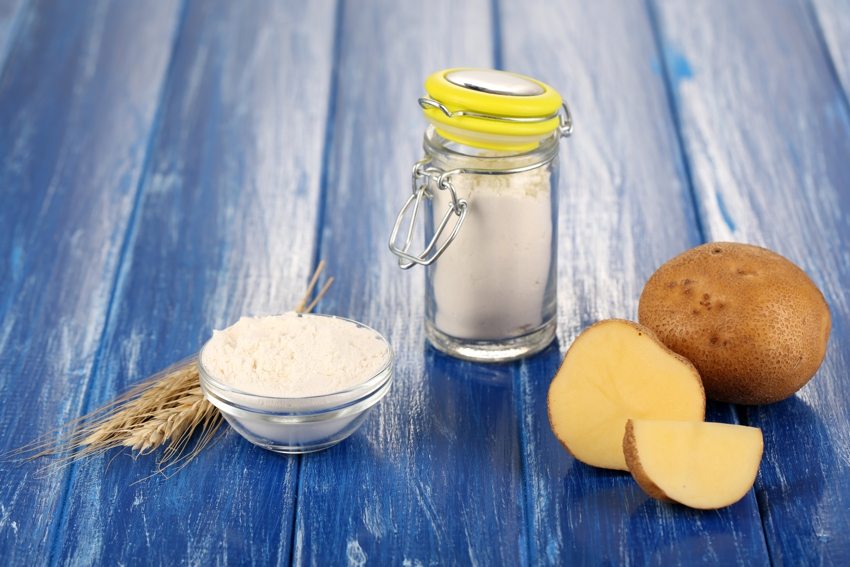Cold Potato, green bananas and legumes all have one thing in common. They all contain high levels of Resistant Starch. Resistant Starch, what is it and why you need it. Before your heart starts racing thinking about what starches potentially can do to your waistline, this is a starch that may, in fact, do the opposite. Intrigued? Read on.
Resistant Starch: What is it and Why you need it
Resistant Starch means a starch that resists digestion. Resistant starch is an undigestible starch that reaches the colon intact and feeds the millions of residing bacteria. This process of reaching the colon intact makes resistant starch a prebiotic – food for bacteria. Prebiotics come in 3 different types, polysaccharides, soluble fibre and resistant starch. They feed different gut bacteria which in turn benefits the health of our colon and digestive system.
There are four types of resistant starch:
RS Type 1 – Starch bound by indigestible plant cell walls; found in beans, grains, and seeds.
RS Type 2 – Starch that is intrinsically indigestible in the raw state due to its high amylose content; found in potatoes, bananas, plantains, type 2 RS becomes accessible upon heating.
RS Type 3 – Retrograded starch; when some starches have been cooked, cooling them (fridge or freezer) changes the structure and makes it more resistant to digestion; found in cooked and cooled potatoes, grains, and beans.
RS Type 4 – Industrial resistant starch; type 4 RS doesn’t occur naturally and has been chemically modified; commonly found in “hi-maize resistant starch.”
Resistant Starch as a Prebiotic
Dietary Fibre is a popular term used as a blanket description of foods that are ultimately good for us, especially our gut health.
Dietary fibre represents a broad class of undigested carbohydrate components. The components vary in chemical and physical nature, and in their physiological outcomes.
For a long time, I had out ruled dietary fibre from my eating plan. Fibre and my gut just didn’t get along. I would have symptoms ranging from abdominal soreness, swelling and often fast bowel transit times resulting in colon spasms. All typical symptoms of IBS, SIBO and poor digestion. I then discovered that there were different types of dietary fibre. Soluble fibre (think psyllium husk) or polysaccharides, (think Inulin or Fructooligosaccharide FOS – onion, garlic, leek, chicory to name a few.) Both of these wreak havoc, but I needed fibre to build that army of healthy gut bacteria to overcome so many of my digestive disorders. That’s when I discovered Resistant Starch.
What’s so great about Resistant Starch?
- Our gut is the home to a trillion bacteria. Some good and some bad. Prebiotics is what feeds the good guys. Resistant Starch selectively feeds the good guys. This food production results in fermentation, producing short-chain fatty acids (acetate, butyrate, and propionate). Out of the three, butyrate is the fatty acid that plays a vital role in the health of the digestive system. Resistant Starch seems to produce more butyrate than any of the other soluble fibres.
- Butyrate is the preferred energy source for the cell lining of the colon. When the lining of the colon wall becomes inflamed, it can permeate causing holes that open up to the bloodstream. Butyrate also decreases inflammation, stimulates the metabolism and improves insulin sensitivity. People suffering from Leaky Gut Syndrome need butyrate to reduce the symptoms and to help heal the lining of the gut.
- Resistant Starch increases stool bulk which helps with constipation and corrects irregularity in bowel movements.
- Resistant Starch improves magnesium absorption. If all the other benefits don’t impress you, then this one should.
Resistant Starch and Weight Loss
Insulin resistance, blood sugar levels and satiety are all components that affect our ability to maintain a healthy weight. Resistant starch can lower the blood glucose levels of a meal, and decrease the sugar spike after eating. It also creates satiety, which means you feel fuller longer.
Resistant Starch also lowers the caloric density of foods as it stays intact until the intestines and feeds the bacteria and not you. The fatty acid, Butyrate, helps to burn fat for fuel instead of carbohydrates as its energy source.
Where to find Resistant Starch?
Foods that contain Resistant starch are:
- Green Bananas (unripe, plantains)
- Banana Flour
- Cooked and cooled potato
- Potato Starch
More foods that contain Resistant Starch are listed here. However, these foods are the ones that I’ve used with reasonable success.
How to add Resistant Starch to your Diet?
It sounds like a silly question, but some people won’t do well with Resistant Starch while others won’t even notice.
As with anyone who has digestive disorders, gut impairment (IBS, SIBO, Candidiasis, Leaky Gut) introducing foods that will ultimately benefit your gut needs monitoring in case of a negative response. If you do happen to suffer from SIBO, resistant starch is probably not going to be a good fit for you. The last thing you need is to feed bacteria that have jumped from the large intestine into the small and make your symptoms worse. Get on top of the SIBO first and then look at introducing Resistant starch.
Guidelines for Using Resistant Starch
The first time I used Banana flour I had quite a sore abdominal area followed by fast transit. Not the most pleasant experience. My first thought was not to eat it at all, which of course is always an option but I wanted to see if I could coax my body so that I could improve the regularity of my bowel movements and ultimately build up the bacteria in my gut. So I cut down on the amount I was having, and this seemed to work well.
- Heating and cooling – Resistant Starch increases in food that’s precooked and cooled. Cold roasted potatoes, potato salad, rice salad or sushi are some of the foods that you can find good levels of Resistant Starch. Bananas should be green, (chewy and chalky on the teeth). Reheated food is possible but at very low temperatures.
- Food or supplements – Many people will prefer to eat a food item as opposed to a flour or powdered version of the food. But there is always the option of using banana flour or potato starch in a smoothie or other cool liquid and down it like a supplement. The recommended dose is approx 15-30 grams a day, or roughly 2-4 tablespoons. Add it to a smoothie or mix it with your yoghurt or a glass of mineral water.
- Eat the whole food – This option is by far the best for a couple of reasons:
- Resistant starch is best taken with other fermentable carbs as a whole food rather than a powder like potato starch. There is some evidence that Resistant Starch taken as a supplement may have some detrimental health issues which you read about here.
- Eating the whole food such as a potato salad is easier and in my opinion a lot yummier. You just simply factor these meals into your daily eating plan.
- Watch out for reactions – if your gut is impaired you will most likely present symptoms like gassiness, bloating, abdominal soreness, diarrhoea, fog head and even headaches.
- Add in probiotics – in a healthy gut, a trillion of the good guys are there just ready to be fed. But sometimes due to gut impairment, we don’t have enough. A probiotic can add more of the good guys to eat more Resistant Starch which will then produce more gut loving benefits and health.
- Reduce or cut it out – You can choose to either stop taking it or cut the amount down even further and slowly increase over a few weeks.
Have you used Resistant Starch before? Will you try it? Check out my 7 Resistant Starch Recipes.
Sources:





























